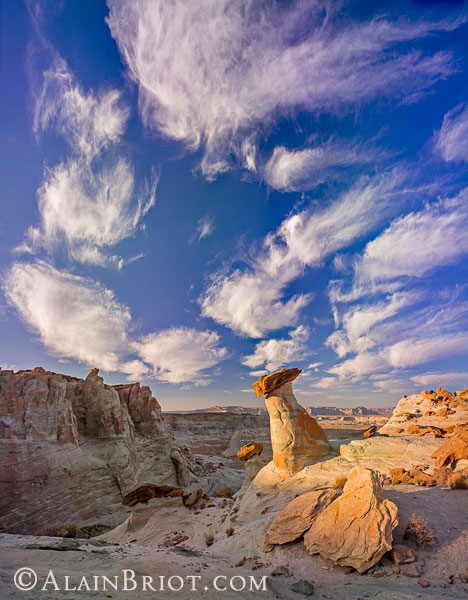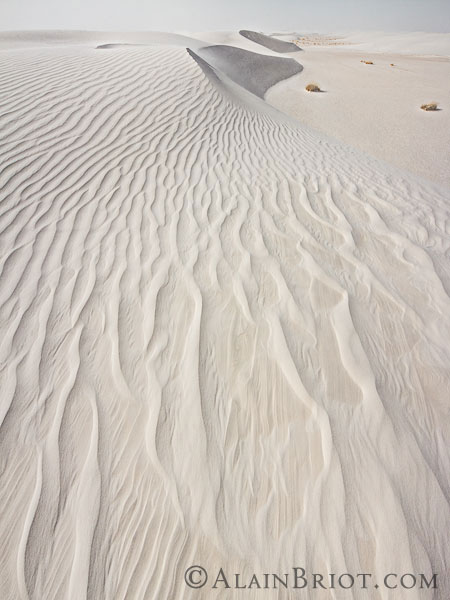It is only through art that we can escape from ourselves and know how another person
sees a universe which is not the same as our own and whose landscapes would otherwise
have remained as unknown as any there may be on the moon.
Marcel Proust
1 – Introduction
It is time to address the subject of creativity in this series of essays about vision. Creativity is a characteristic that we need to develop because the ability to express a vision is based on being creative. In this essay I go over the characteristics that influence creativity. I continue by offering guidance about how to develop your creativity. Finally, I conclude with an example of an artist who thought that ignoring his own creativity was going to make him successful in the fine art world.
2 – The Characteristics of creative people
Knowing what makes people creative is essential in becoming more creative ourselves. To this end here is a list of characteristics shared by creative people. As you read through this list, keep in mind that you don’t need to have all these characteristics to be creative. The goal is to have some of these characteristics, not necessarily all of them. If you find this list overwhelming, take a look at the Skill Enhancement Exercises in Section 3. These simplify things a bit because they focus on developing your skills in the most important aspects of creativity.
– Creative people live in an interactive world. They talk to other people, exchange ideas, ask questions and explore creative concepts with other like-minded people.
– Creative people want to do their best. They take pride in what they do. They focus on details and they do not stop until they are satisfied with the outcome of their work. They are focused on achieving their goals. They want to be remembered for their artistic accomplishments and they do not cut corners when working towards their goals.
– Creative people want to encourage others to do their best. To achieve this goal they offer feedback based on their personal approach and their experience of creative endeavors. When helping others they are supportive rather than critical. Their goal is to help others reach their full potential and discover their creative self, not to force others do the same things they do. Creative people are generous with their knowledge. They want to share what they know. They see sharing their knowledge a way to give back to others what they were given themselves and help others reach their full potential.
– Creative people often become leaders because they want to show the way. Doing so is not motivated by the desire to be didactic but rather by the desire to demonstrate what life has to offer through their actions and their guidance. When they succeed they want to share the reasons for their success so that others can succeed as well.
– Creative people are expressive. Their projects are focused on what inspires them. Because of this focus their work reveal something about who they truly are.
– The work of creative people work is bold and their approach is courageous. They use their work to express who they are, not to hide behind their creations. They don’t hesitate to take chances with their work by trying new things, exploring new venues of creativity, new tools, new software, new everything. They are interested in exploring the possibilities offered by what is available to them.

Surrealist Cloudscape Hoodoo
– The goal of creative people is not to reach perfection. In fact, most creative people consider perfection to be unattainable. Instead, their goal is to reach their full artistic and personal potential.
– Creative people are not afraid to make mistakes. On the contrary, they consider making mistakes one of the fundamental aspects of creativity. For them, trying new tools, exploring new venues and doing things that have not been done before involves making mistakes. Mistakes are inevitable, expected and embraced. Rather than be afraid of making mistakes they consider mistakes to be learning opportunities. Mistakes are the path one needs to take when looking for an effective solution to a specific problem. The solution that works is the one that is left when everything else has been tried and proven not to work.
– Creative people are non-judgmental. They are focused on making, not on criticizing. I often credit living in Navajoland, where we spent 7 years, as being the beginning of my professional artistic career. This is in large part due to the non-judgmental nature of Navajo culture. While living there, instead of asking myself ‘what will they think of my work?’ I ask myself ‘what kind of images can I create?’ I focused on creating images, not on whether these images would be criticized or not. Why? Simply because there was no criticism to worry about. If you want to know more about my experience living in Navajoland listen to my new Podcast series titled ‘Living and Photographing in Navajoland.’
– The personality of creative people is based on change. Rather than being static and unmovable, their personality is based on flow and change. They embrace new ideas and are not afraid to change their mind and their approach to their work and their life when they discover something they consider to be better than what they did so far.
– Creative people often oppose rules, conventions and accepted norms. They are rebellious rather than consenting. Their goal is to create their own world rather than fit into the existing world. They create the things they want because they do not find these things ready-made.
– Creative people are motivated by interaction rather than by competition. While they may engage in competitive endeavors, winning is usually not their primary goal. Their primary goal is interacting and learning from other artists and from participants if they participate in a contest.
– Creative people work hard at discovering who they truly are. They take classes, complete exercises and practice developing their creativity in order to find out what makes them unique and different. Once they find that out they work towards showing who they are to their audience and to the world through their work, their actions and their physical presence.
– Creative people are comfortable with who they are and how they are perceived with others. They feel secure about their personality, their physical presence and their personal and interactive skills.
– As a result, creative people have a low level of anxiety about life. Life is generous to them. They give a lot and they receive a lot and this exchange squelches their anxiety.
– Finally, creative people experience a high level of self-actualization (see Maslow’s pyramid of needs).
3 – Skill enhancement exercise: fostering your creativity
Reading the list above can be overwhelming. You might feel that you will never have all these characteristics. If so keep in mind that few people have all the characteristics listed above. This is an exhaustive list, one that features the characteristics found in many different people rather than in a single person.
Also keep in mind that the goal is not to acquire all the characteristics on the list. Instead, the goal is to expand your creativity to its full potential and achieve the highest level of self actualization. In art, this means the creation of a body of work that consistently demonstrates your unique personal style.
If your goal is to become more creative, this section features guidance about how you can get this done. This guidance is outlined in the 5 steps outlined below:
1: Learn not to be afraid to make mistakes
You need to learn not to fear making mistakes. You may have a job in which making a mistake will get you fired, ridiculed, outcast or worse. This is unfortunate but the good news is that fine art photography is a very different type of endeavor. In fine art photography there are no negative consequences to making mistakes. You will not be fired. You will not lose your job. You will not be ridiculed by others. You will not be outcast. At worst someone may not like your work.
2: Change your audience
You may say ‘I showed my work to others and they made fun of my mistakes.’ If this happened it is because your showed you work to people who are themselves deadly afraid to make mistakes. If this is the case you need to change your audience. You need to find a new audience, one that does not punish you, or make you feel bad, if you make mistakes.
3: Learn to not be defensive about your work
We are defensive because we fear other people’s response to our work. In other words we are afraid to be criticized. After you complete step 2 you will have found an audience that is supportive of your creative efforts, an audience that is not going to make you feel bad or be critical if you make a mistake. It is when you stop being defensive that you will start being creative. Defensiveness pushes away inspiration. It creates a barrier that inspiration cannot go through. When you remove this barrier you invite inspiration and allow it to flow into your world. Because inspiration is the key to creativity, by letting inspiration in you will in turn become more creative.
4: Take chances with your work
You have completed step 3 and you are now inspired instead of defensive. Creativity is flowing into your work. It is now time to take chances and to do things that you have not tried before. There may be things you wanted to do for a long time but were afraid to try. If so, try them now. Or, you may have seen others do things you wanted to do yourself but did not allow yourself to do. If so, try doing these things now. You are no longer afraid to make mistakes, so it is only a matter of getting started and of doing something exciting.
5: Work towards creating a body of work
This is the ultimate goal. It is also a long term goal. We will return to how this goal can be achieved later on in this series when we look at how to design, work and complete projects.

Monument Valley Avant Garde
4 – Example: Maintaining your vision
An example will be useful to illustrate the relationship between being creative and being successful.
This example is about an artist who felt he had to do what others wanted in order to be successful selling his work. While you may not be interested in selling your work, this example is still valuable because the same issues are involved if you show your work without selling it.
The artist featured in this story – Jay – was defensive and fearful of criticism. He thought that trying to please everyone would bring him success in the world of art. However, as the story shows, success in art comes from being creative, not from being defensive and trying to please everyone.
The problem
Jay has been trying to sell his work, unsuccessfully, for years. After moving to a new location, Jay approached one of the local art galleries to seek representation. After seeing his work, the gallery owner told him that even though he is very talented, his style of work will not sell in her gallery because it does not fit in with the style of the other artists she represents and because it is not what her collectors are looking for.
Depressed by these news, Jay told her that he can photograph any subject and create pieces in any style that she wants. ‘Just let me know what you want and I will do it’ Jay explained.
Upon hearing this the gallery owner tells Jay that she will contact him later on but that right now his work is just not the right fit for her gallery. In reality, learning that Jay is willing to do anything to make a sale has turned her off forever from taking an interest in Jay’s work. This is because as an art connoisseur, she values passion and integrity and she has esteem for artists who stand up for their style, not for those who are willing to do anything to become popular.
Jay’s attitude, rather than his current work, is what turned her off. She realized that he is simply not willing to stand behind his style, and this is exactly the opposite of what she is looking for in an artist.
The solution
Jay needs to stop trying to do anything to make a sale or to please the people he interacts with. When his attitude changes, his level of success will increase. But if he continues to have his current attitude, he will continue to meet people that are not interested in working with him.
5 – Conclusion
I will continue this exploration of the subject of creativity in a future essay in this series. In this upcoming essay I will address the subject of what creativity really means when it comes to our understanding of art. Until then, and to use my French, this series isa suivre.

White Sandstorm in White Sands
6 – About the photographs featured here and in my other essays
The photographs featured here were modified to reflect my artistic vision. To this end, rather than present the raw images captured by the camera, I altered the colors, contrast, forms, contents, format, dynamic range and other aspects of each image. Depending on the image items may have been removed or added or several photographs may have been collaged together. As a result the images you see here should not be construed as something that truly exists. They are intended to be seen as a representation of my creativity, artistic intent and desire to create a unique world rather than document the world we all have access to.
7 – About Alain Briot
I create fine art photographs, teach workshops and offer DVD tutorials on composition, image conversion, optimization, printing and marketing. I am the author of Mastering Landscape Photography, Mastering Photographic Composition, Creativity and Personal Style and Marketing Fine Art Photography. All 3 books are available in eBook format on my website at this link: http://beautiful-landscape.com/Ebooks-Books-1-2-3.html
You can find more information about my work, writings and tutorials as well as subscribe to my Free Monthly Newsletter on my website at http://www.beautiful-landscape.com . You will receive 40 free eBooks immediately after subscribing.
I welcome your comments on this essay as well as on my other essays. You can reach me directly by emailing me at alain@beautiful-landscape.com.
Alain Briot
Arizona
August, 2013
You May Also Enjoy...
Long Exposure With A Purpose
FacebookTweet Long Exposure photography has existed since the days of the first images recorded, however, today Long Exposure, or should I rephrase and say, Daytime

